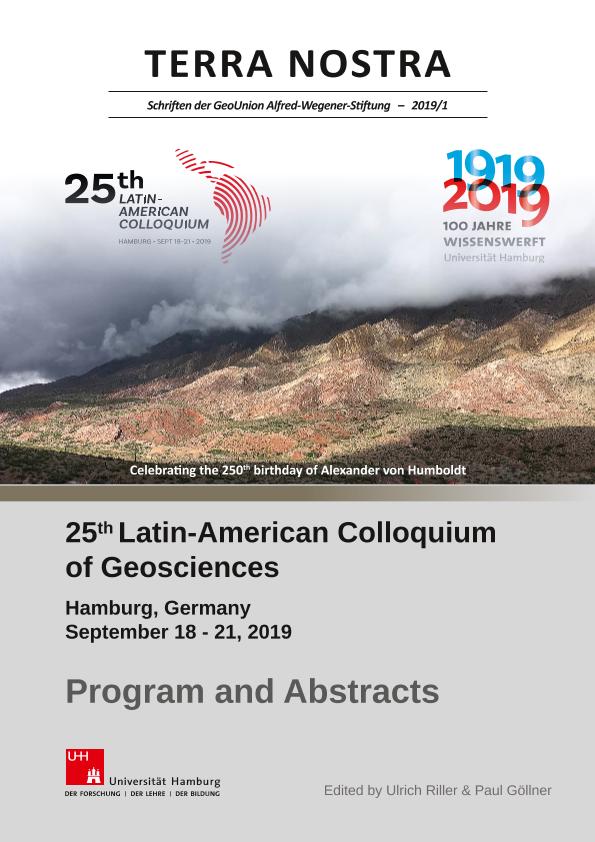Mostrar el registro sencillo del ítem
dc.contributor.author
López, Manuel

dc.contributor.author
Bucher, Joaquin

dc.contributor.author
García, Micaela Romina

dc.contributor.author
D'Elia, Leandro

dc.contributor.author
Bilmes, Andrés

dc.contributor.author
Franzese, Juan Rafael

dc.contributor.other
Riller, Ullrich
dc.contributor.other
Göllner, Paul
dc.date.available
2023-07-20T11:10:35Z
dc.date.issued
2019
dc.identifier.citation
Miocene volcaniclastic foreland basin infill next to the exhumed north patagonian andean batholith: a record of collapse-caldera eruptions?; 25th Latin-American Colloquium of Geoscience; Hamburgo; Alemania; 2019; 59-60
dc.identifier.issn
0946-8978
dc.identifier.uri
http://hdl.handle.net/11336/204538
dc.description.abstract
The nature of Andean magmatism and their tectonic regimes results from variations in the angle of subduction of the Nazca and Antartic oceanic plates beneath South American plate. For the Patagonian Andes, a flat slab type subduction was proposed to the middle Miocene and the Patagonian Broken Foreland system was defined. At one time, foreland basins were filled with tens of primary and resedimented volcaniclastic materials that were distributed for more than 30.000 km2. In order to understand the relationship between tectonics and magmatic?volcanic feeder system interactions, we analysis the Miocene volcaniclastic infill succession of a basin located next to the exhumed Andean Batholith: the Collón Cura basin.The Collón Cura basin was mainly configured between 16 and 14.4 Ma due to the uplift of the north Patagonian Andes towards the west and the Sañicó Massif towards the east, evidencing the onset of the Patagonian Broken Foreland system. The uplift of the Patagonian Andes continues up to 4.8Ma. At the same time, a volcaniclastic succession of tuffs, lapilli tuffs and tuffaceous sandstones were deposited into the basin with up to 150 m-thick that reach an estimated volume of ~1800 km3. The succession is limited below by an angular unconformity and above by a regional erosional unconformity. Internally, the succession is characterized by three sections. The lower and upper sections are composed of ~50 - 70 m-thick of massive to roughly stratified and moderate-sorted vitric-rich lapilli tuff and tuffaceous sandstones. The middle section is characterized by 10 to 30 m thick of lenticular beds composed of massive, vitric-rich and moderately sorted lapilli-tuffs. Preliminary geochronological and magnetostratigraphic analysis constrain the volcaniclastic succession between 15.160 and 12.049 Ma and reveals that the whole succession has a normal polarity paleopole dated between 15.160 and 15.032 Ma, determining a maximum depositional time process of 128.000 years. Nevertheless, sedimentological features of the succession indicate that deposits were probably deposited even in a much shorter time span.During the proto- and Andean cycles, tectono-magmatic scenarios prone to collapse-caldera eruptions were recorded. In this contribution we interpret the deposition of the volcaniclastic succession as short-term processes associated with PDC´s occurred during the main structural configuration of the basin that matches with the contractional flat slab regime. The volcaniclastic succession of the Collón Cura basin would record a huge volcanic eruption deposited by catastrophic events in a many or nested collapse-caldera scenario. The origin of the calderas would be genetically associated with Miocene igneous rocks of the North Patagonian Batholith, that was exhumed in the North Patagonian Andean axis after the flat slab regime.
dc.format
application/pdf
dc.language.iso
eng
dc.publisher
Schriften GeoUnion Alfred Wegener-Stiftung
dc.rights
info:eu-repo/semantics/openAccess
dc.rights.uri
https://creativecommons.org/licenses/by/2.5/ar/
dc.subject
TECTONICS
dc.subject
PATAGONIAN BROKEN FORELAND
dc.subject
COLLON CURA
dc.subject.classification
Geología

dc.subject.classification
Ciencias de la Tierra y relacionadas con el Medio Ambiente

dc.subject.classification
CIENCIAS NATURALES Y EXACTAS

dc.title
Miocene volcaniclastic foreland basin infill next to the exhumed north patagonian andean batholith: a record of collapse-caldera eruptions?
dc.type
info:eu-repo/semantics/publishedVersion
dc.type
info:eu-repo/semantics/conferenceObject
dc.type
info:ar-repo/semantics/documento de conferencia
dc.date.updated
2022-11-14T15:32:42Z
dc.journal.pagination
59-60
dc.journal.pais
Alemania

dc.journal.ciudad
Hamburgo
dc.description.fil
Fil: López, Manuel. Consejo Nacional de Investigaciones Científicas y Técnicas. Centro Científico Tecnológico Conicet - La Plata. Centro de Investigaciones Geológicas. Universidad Nacional de La Plata. Facultad de Ciencias Naturales y Museo. Centro de Investigaciones Geológicas; Argentina
dc.description.fil
Fil: Bucher, Joaquin. Consejo Nacional de Investigaciones Científicas y Técnicas. Centro Científico Tecnológico Conicet - La Plata. Centro de Investigaciones Geológicas. Universidad Nacional de La Plata. Facultad de Ciencias Naturales y Museo. Centro de Investigaciones Geológicas; Argentina
dc.description.fil
Fil: García, Micaela Romina. Consejo Nacional de Investigaciones Científicas y Técnicas. Centro Científico Tecnológico Conicet - La Plata. Centro de Investigaciones Geológicas. Universidad Nacional de La Plata. Facultad de Ciencias Naturales y Museo. Centro de Investigaciones Geológicas; Argentina
dc.description.fil
Fil: D'Elia, Leandro. Consejo Nacional de Investigaciones Científicas y Técnicas. Centro Científico Tecnológico Conicet - La Plata. Centro de Investigaciones Geológicas. Universidad Nacional de La Plata. Facultad de Ciencias Naturales y Museo. Centro de Investigaciones Geológicas; Argentina
dc.description.fil
Fil: Bilmes, Andrés. Consejo Nacional de Investigaciones Científicas y Técnicas. Centro Científico Tecnológico Conicet - Centro Nacional Patagónico; Argentina
dc.description.fil
Fil: Franzese, Juan Rafael. Consejo Nacional de Investigaciones Científicas y Técnicas. Centro Científico Tecnológico Conicet - La Plata. Centro de Investigaciones Geológicas. Universidad Nacional de La Plata. Facultad de Ciencias Naturales y Museo. Centro de Investigaciones Geológicas; Argentina
dc.relation.alternativeid
info:eu-repo/semantics/altIdentifier/doi/https://doi.org/10.23689/fidgeo-3609
dc.relation.alternativeid
info:eu-repo/semantics/altIdentifier/url/https://e-docs.geo-leo.de/handle/11858/7935
dc.conicet.rol
Autor

dc.conicet.rol
Autor

dc.conicet.rol
Autor

dc.conicet.rol
Autor

dc.conicet.rol
Autor

dc.conicet.rol
Autor

dc.coverage
Internacional
dc.type.subtype
Otro
dc.description.nombreEvento
25th Latin-American Colloquium of Geoscience
dc.date.evento
2019-09-18
dc.description.ciudadEvento
Hamburgo
dc.description.paisEvento
Alemania

dc.type.publicacion
Journal
dc.description.institucionOrganizadora
Universitat Hamburg
dc.source.libro
Abstract book- Latin American Colloquium
dc.source.revista
Terra Nostra
dc.date.eventoHasta
2019-09-21
dc.type
Otro
Archivos asociados
